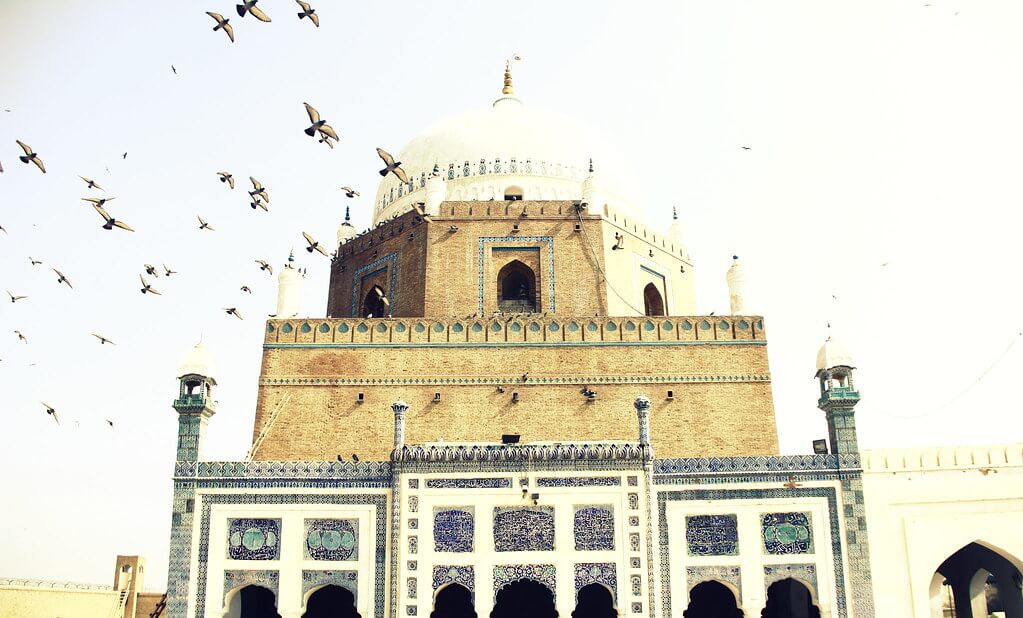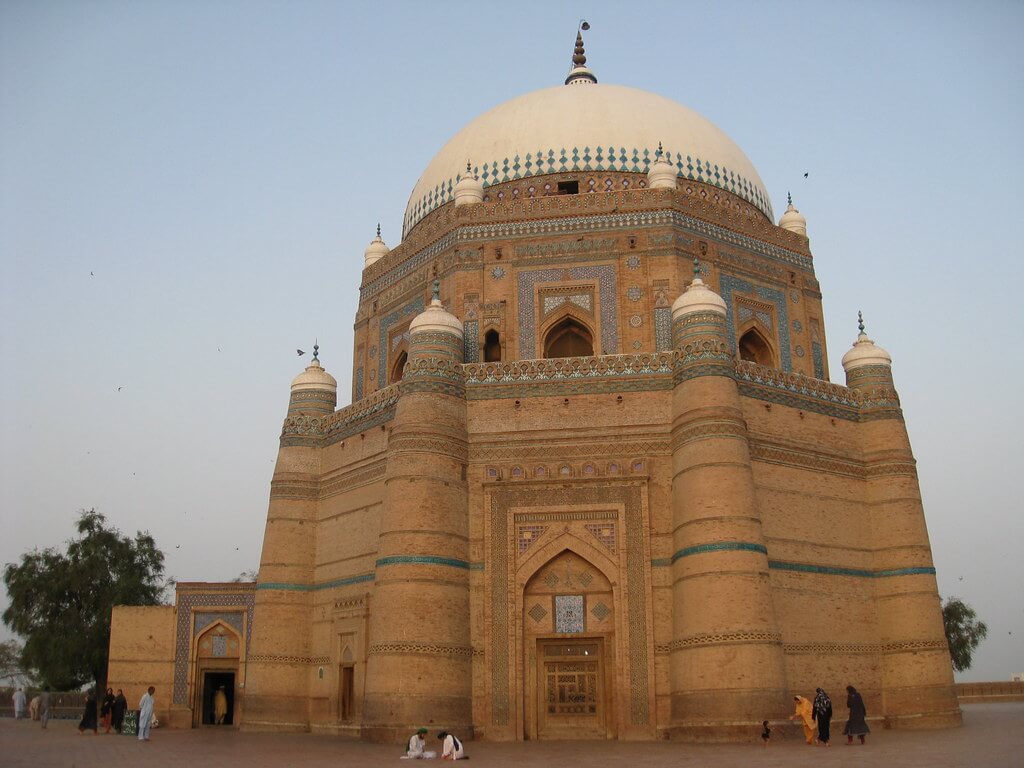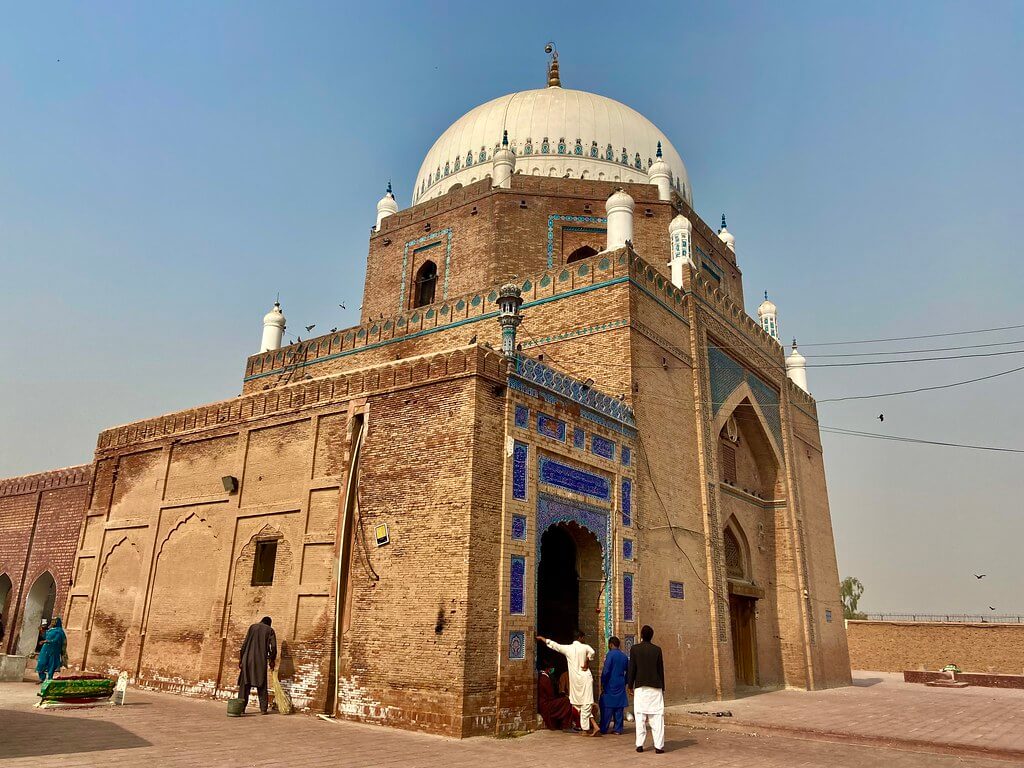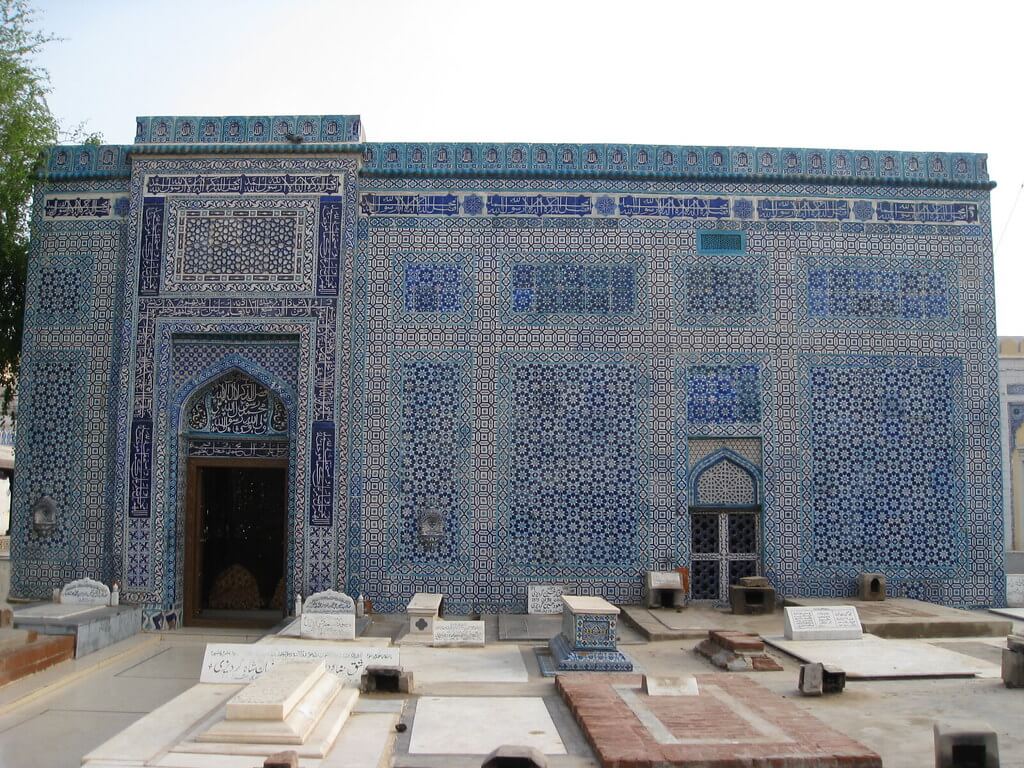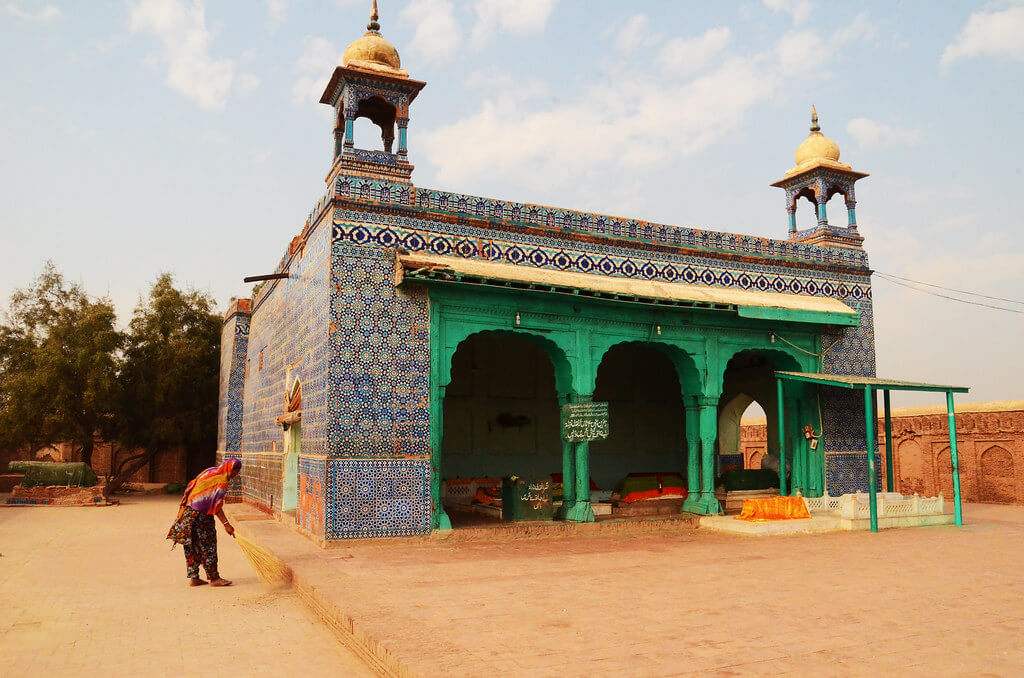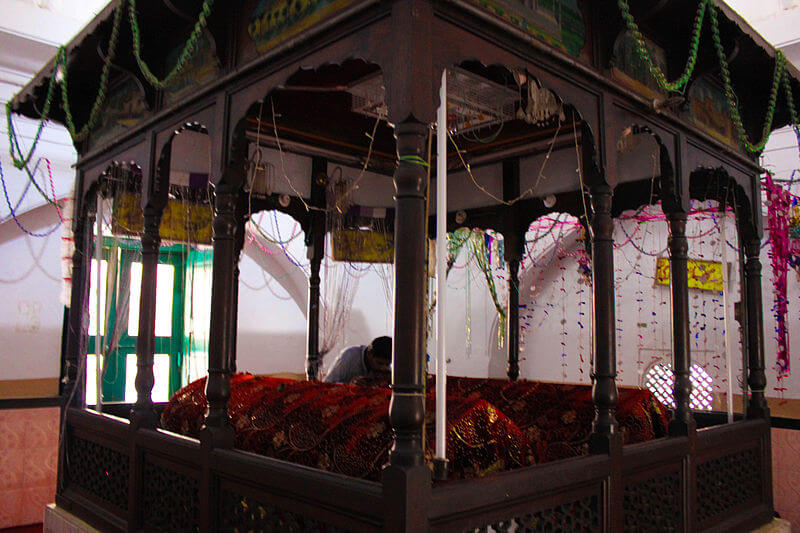Shrines in Multan: A Spiritual Oasis in the Heart of Pakistan
Shrines in Multan, Multan, located in the center of Pakistan, has a long history and unique cultural heritage. One of the city’s most notable features is its numerous shrines, which are spread across the area and serve as a monument to its spiritual significance.
The Shrine of Bahauddin Zakaria
Another mausoleum may be found in the shadow of Shah Rukn-e-Alam’s tomb: the Shrine of Bahauddin Zakariya. The temple is nearly identical in virtually every regard, yet it lacks some of the grandiosity that makes its neighbor a marvel of construction. Instead of admiring the gorgeous building, visitors to this Sufi shrine might try to obtain another unique peek into Sufi customs. Many devotees approach the interior of this dome with flowers in hand to pray in front of Bahauddin Zakariya’s casket and to pay their respects by throwing pink flower petals on his tomb.
Built in 1262, this mausoleum, like the others in Multan Fort, invites visitors to return to a peaceful time before fanaticism and terrorism. This mausoleum is particularly well-known for its qawwali nights, which feature music played on a harmonium following evening prayers. while the sun sets, Muslims from all over Multan will gather in the courtyard, sit on the ground, and sway back and forth while the sound of music resonates into the night.
The shrine of Shah Rukn-e-Alam
Another well-known shrine in Multan is Shah Rukn-e-Alam. It honors Shah Rukn-e-Alam, a Sufi saint and grandson of Sheikh Baha-ud-Din Zakariya. The temple is famous for its beautiful architecture, which features a big dome and delicate tilework.
The shrine of Shah Shams Sabzwari
The Shrine of Shah Shams Sabzwari honors Shah Shams Sabzwari, a Sufi saint from the 12th century. The shrine is located in Multan’s old city and is a renowned destination for spiritual seekers.
- Shams Uddin Sabzwari arrived in Multan in early 1200 C.E.
- Founded a dargah to promote Islam.
- Located half a mile from Multan Fort.
- Built along the high bank of the former bed of the Ravi River.
- The shrine was constructed by his grandson around 1330.
- It is capped with a hemispherical dome.
- The mausoleum is adorned with ornate glazed tiles.
- The Urs of Shah Shams is held at the tomb every year in June.
The Shrine of Shah Gardez
The Shah Gardez Shrine is located on the far western edge of Multan’s huge market. Tucked away from the hustle and bustle of the market, the only way to get near this darbar is to circle some type of walled enclosure. The modest-looking entryway of decaying red bricks leads to a vast courtyard with tall spires, a marble grave, and mosaic-covered tombstones.
The tomb itself is modest in size but compensates for its lack of enormous domes with stunning blue tiles. The box-sized tomb is located amid the darbar, with pigeons continually flying overhead. Although the grounds are barren, a photographer may easily spend hours photographing various viewpoints of the Shah Yousuf Gardezi Tomb. In recent years, this place has also seen sectarian strife and terrorist strikes. The cops patrolling the compound may feel nervous and chase you out of the darbar.
Shrine of Bibi Pak Daman
The Shrine of Bibi Pak Daman, located near Hussain Agahi, is devoted to the seven female companions (wives and relatives) of Hazrat Ali (RA), Islam’s fourth caliph. Bibi Pak Daman, or ‘the chaste woman’ in English, is a famous site for ladies seeking blessings for themselves and their families.
The shrine, thought to have been established in the 11th century, is one of Multan’s oldest. It is reported that the seven ladies buried here fled to Multan after being persecuted for their beliefs in their homeland.
The shrine’s construction combines classic Islamic and Mughal traditions, with a white marble facade and beautifully carved marble screens. The inside of the shrine is decorated with exquisite paintings and Quranic calligraphy.
The shrine of Hameed-ud-Din Hakim
The Shrine of Hameed-ud-Din Hakim honors a notable Sufi saint, philosopher, and poet from the 16th century. The shrine, located in the Shah Rukn-e-Alam Colony, has stunning architecture and is a spiritual and culturally significant landmark.
Hameed-ud-Din Hakim was a major person in the Chishti Sufi order who is credited for popularizing Sufism in the Multan region. His teachings stressed love, peace, and tolerance, and he was respected for his devotion and knowledge.
The temple is a superb example of Mughal architecture, with its red sandstone walls, marble dome, and delicate tile work. The interior of the shrine is decorated with magnificent calligraphy and Quranic texts.
Devotees come to the shrine to seek blessings and instruction from the saint. It is claimed that the prayers given here are heard and answered.
Shrine of Qutab-al-Qutaab “Moj Dariya”
This shrine, located near Basti Daira, honors Qutab-al-Qutaab, a well-known Sufi saint and poet. The temple is noted for its serene atmosphere and is a popular destination for people seeking spiritual consolation.
Qutab-al-Qutaab is thought to have been a pupil of Hazrat Shah Shams Tabriz, the well-known Persian mystic and Rumi’s teacher. His teachings highlighted the value of love, compassion, and dedication to God.
The shrine is designed in the typical Islamic style, with a white marble facade and a domed ceiling. The interior of the shrine is decorated with magnificent calligraphy and Quranic texts.
Shrine of Syed Pir Sakhi Shah Hassan Parwana
This shrine, located in Qutabpur, is dedicated to Syed Pir Sakhi Shah Hassan Parwana, a well-known Sufi saint and scholar. The shrine draws devotees from all across the country, who come to pay their respects and seek favors.
Syed Pir Sakhi Shah Hassan Parwana was a prominent Sufi saint who lived in the 16th century. He was revered for his holiness, and his teachings highlighted the value of love, compassion, and dedication to God.
The shrine is designed in the typical Islamic style, with a white marble facade and a domed ceiling. The interior of the shrine is decorated with magnificent calligraphy and Quranic texts.
The shrine of Qazi Qutab-ud-Din Kashani
This shrine, located near the Bohar Gate, honors Qazi Qutab-ud-Din Kashani, a well-known Sufi saint and philosopher. The shrine is noted for its stunning architecture and holds spiritual importance.
Qazi Qutab-ud-Din Kashani was a major person in the Chishti Sufi order who is credited for popularizing Sufism in the Multan region. His teachings highlighted the value of love, compassion, and dedication to God.
The shrine is designed in the typical Islamic style, with a white marble facade and a domed ceiling. The interior of the shrine is decorated with magnificent calligraphy and Quranic texts.
Shrine of Syed Hasan Khanjzeez
This shrine honors Syed Hasan Khanjzee, a Sufi saint and poet. The shrine, located in the Hussain Agahi region, is a popular location for pilgrims looking for spiritual advice.
Syed Hasan Khanjzee, a prominent Sufi saint, flourished in the 12th century. He was revered for his holiness, and his teachings highlighted the value of love, compassion, and dedication to God.
The shrine is designed in the typical Islamic style, with a white marble facade and a domed ceiling. The interior of the shrine is decorated with magnificent calligraphy and Quranic texts.
Shrine to Hazrat Shah Dana Shaheed
This shrine in Mumtazabad honors Hazrat Shah Dana Shaheed, a Sufi saint and martyr. The shrine is noted for its calm atmosphere and holds spiritual importance.
Hazrat Shah Dana Shaheed was a Sufi saint who lived during the 13th century. He was revered for his holiness, and his teachings highlighted the value of love, compassion, and dedication to God.
The shrine is designed in the typical Islamic style, with a white marble facade and a domed ceiling. The interior of the shrine is decorated with magnificent calligraphy and Quranic texts.
Shrine of Abu Hassan Hafiz Jamal-ud-Din “Musa Pak Shaheed”
Abu Hassan Hafiz Jamal-ud-Din “Musa Pak Shaheed”, a Sufi saint and martyr, is honored at this shrine near Mumtazabad. The shrine is a popular spot for those looking for spiritual advice and benefits.
Abu Hassan Hafiz Jamal-ud-Din “Musa Pak Shaheed” was a prominent Sufi saint from the 15th century. He was revered for his holiness, and his teachings highlighted the value of love, compassion, and dedication to God.
The shrine is designed in the typical Islamic style, with a white marble facade and a domed ceiling. The interior of the shrine is decorated with magnificent calligraphy and Quranic texts.
Conclusion
Finally, Shrines in Multan reflect the city’s rich spiritual past. They are not simply places of worship, but also of rest and tranquillity. Whether you are a devoted Sufi or simply want to enjoy the city’s rich history and culture, Multan’s shrines are a must-see.


